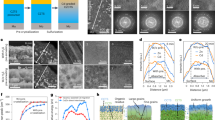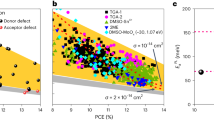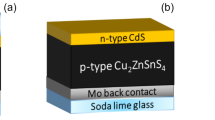Abstract
Sulfide kesterite Cu2ZnSnS4 (CZTS) is a competitive photovoltaic material, especially for multijunction solar cells. However, the device power conversion efficiency has remained stagnant for years. Deep-level defects, such as sulfur vacancies (VS), cause serious non-radiative recombination of charge carriers. Here we propose a passivation strategy for VS through the heat treatment of the CdS/CZTS heterojunction in an oxygen-rich environment. In this process, VS are occupied by oxygen atoms, suppressing VS defects. In addition, the diffusion of Cd ions to the CZTS absorber layer, and the formation of positive Na–O and Sn–O complexes can passivate related defects. These effects led to a reduced charge recombination and favourable band alignment. We demonstrate a certified efficiency of 11.51% for air-solution-processed CZTS solar cells (bandgap of 1.5 eV) without any extrinsic cation alloying. The study offers insights into defect passivation and performance improvement mechanism of kesterite solar cells.
This is a preview of subscription content, access via your institution
Access options
Access Nature and 54 other Nature Portfolio journals
Get Nature+, our best-value online-access subscription
$32.99 / 30 days
cancel any time
Subscribe to this journal
Receive 12 digital issues and online access to articles
$119.00 per year
only $9.92 per issue
Buy this article
- Purchase on SpringerLink
- Instant access to full article PDF
Prices may be subject to local taxes which are calculated during checkout




Similar content being viewed by others
Data availability
The data that support the findings of this study are available from the corresponding author upon reasonable request. The data that support the findings of this study are available within the Article and its Supplementary Information. Source data are provided with this paper.
References
Green, M. A. et al. Solar cell efficiency tables (version 49). Prog. Photovoltaics Res. Appl. 25, 3–13 (2016).
Pal, K. et al. Current challenges and future prospects for a highly efficient (>20%) kesterite CZTS solar cell: a review. Sol. Energy Mater. Sol. Cells 196, 138–156 (2019).
Kirchartz, T. et al. What makes a good solar cell? Adv. Energy Mater. 8, 1703385 (2018).
Baid, M. et al. A comprehensive review on Cu2ZnSnS4 (CZTS) thin film for solar cell: forecast issues and future anticipation. Opt. Quantum Electron. 53, 656 (2021).
Green, M. A. et al. Solar cell efficiency tables (version 64). Prog. Photovoltaics Res. Appl. 32, 425–441 (2024).
Su, Z. et al. Device postannealing enabling over 12% efficient solution-processed Cu2ZnSnS4 solar cells with Cd2+ substitution. Adv. Mater. 32, e2000121 (2020).
Shi, J. et al. Multinary alloying for facilitated cation exchange and suppressed defect formation in kesterite solar cells with above 14% certified efficiency. Nat. Energy 9, 1095–1104 (2024).
Wang, W. et al. Device characteristics of CZTSSe thin‐film solar cells with 12.6% efficiency. Adv. Energy Mater. 4, 1301465 (2013).
Yan, C. et al. Cu2ZnSnS4 solar cells with over 10% power conversion efficiency enabled by heterojunction heat treatment. Nat. Energy 3, 764–772 (2018).
Gong, Y. et al. Sn4+ precursor enables 12.4% efficient kesterite solar cell from DMSO solution with open circuit voltage deficit below 0.30 V. Sci. China Mater. 64, 52–60 (2020).
Chen, S. et al. Classification of lattice defects in the kesterite Cu2ZnSnS4 and Cu2ZnSnSe4 earth-abundant solar cell absorbers. Adv. Mater. 25, 1522–1539 (2013).
Scragg, J. J. et al. Effects of back contact instability on Cu2ZnSnS4 devices and processes. Chem. Mater. 25, 3162–3171 (2013).
Karade, V. et al. Insights into kesterite’s back contact interface: a status review. Sol. Energy Mater. Sol. Cells 200, 109911 (2019).
Crovetto, A. et al. What is the band alignment of Cu2ZnSnS(Se)4 solar cells? Sol. Energy Mater. Sol. Cells 169, 177–194 (2017).
Kim, S. et al. Identification of killer defects in kesterite thin-film solar cells. ACS Energy Lett. 3, 496–500 (2018).
Duan, B. et al. Underlying mechanism of the efficiency loss in CZTSSe solar cells: disorder and deep defects. Sci. China Mater. 63, 2371–2396 (2020).
Nisika et al. Progress and prospects of CZTSSe/CdS interface engineering to combat high open-circuit voltage deficit of kesterite photovoltaics: a critical review. J. Mater. Chem. A 8, 21547–21584 (2020).
Zhou, J. et al. Control of the phase evolution of kesterite by tuning of the selenium partial pressure for solar cells with 13.8% certified efficiency. Nat. Energy 8, 526–535 (2023).
Gong, Y. et al. Ag incorporation with controlled grain growth enables 12.5% efficient kesterite solar cell with open circuit voltage reached 64.2% Shockley–Queisser limit. Adv. Funct. Mater. 31, 2101927 (2021).
Gong, Y. et al. Identifying the origin of the VOC deficit of kesterite solar cells from the two grain growth mechanisms induced by Sn2+ and Sn4+ precursors in DMSO solution. Energy Environ. Sci. 14, 2369–2380 (2021).
Liu, F. et al. Nanoscale microstructure and chemistry of Cu2ZnSnS4/CdS interface in kesterite Cu2ZnSnS4 solar cells. Adv. Energy Mater. 6, 1600706 (2016).
Fan, P. et al. Enhancing Ag-alloyed Cu2ZnSnS4 solar cell performance by interfacial modification via In and Al. J. Mater. Chem. A 9, 25196–25207 (2021).
Yin, W. J. et al. Engineering grain boundaries in Cu2ZnSnSe4 for better cell performance: a first‐principle study. Adv. Energy Mater. 4, 1300712 (2013).
Gokmen, T. et al. Band tailing and efficiency limitation in kesterite solar cells. Appl. Phys. Lett. 103, 103506 (2013).
Li, J. et al. Unveiling microscopic carrier loss mechanisms in 12% efficient Cu2ZnSnS4 solar cells. Nat. Energy 7, 754–764 (2022).
Grossberg, M. et al. Photoluminescence study of defect clusters in Cu2ZnSnS4 polycrystals. Curr. Appl. Phys. 14, 447–450 (2014).
Nellist, P. D. & Pennycook, S. J. Incoherent imaging using dynamically scattered coherent electrons. Ultramicroscopy 78, 111–124 (1999).
Rafferty, B. et al. On the origin of transverse incoherence in Z-contrast STEM. J. Electron Microsc. 50, 227–233 (2001).
Maticiuc, N. et al. XPS study of OH impurity in solution processed CdS thin films. Sol. Energy Mater. Sol. Cells 160, 211–216 (2017).
Zhou, S. et al. Accelerating electron-transfer and tuning product selectivity through surficial vacancy engineering on CZTS/CdS for photoelectrochemical CO2 reduction. Small 17, e2100496 (2021).
Fumitaka Goto, K. S. Masaya Ichimura defect reduction in electrochemically deposited CdS thin films by annealing in O2. Sol. Energy Mater. Sol. Cells 50, 147–153 (1998).
Grini, S. et al. Strong interplay between sodium and oxygen in kesterite absorbers: complex formation, incorporation, and tailoring depth distributions. Adv. Energy Mater. 9, 1900740 (2019).
Sardashti, K. et al. Impact of nanoscale elemental distribution in high‐performance kesterite solar cells. Adv. Energy Mater. 5, 1402180 (2015).
Yu, Z. et al. Unveiling the selenization reaction mechanisms in ambient air‐processed highly efficient kesterite solar cells. Adv. Energy Mater. 13, 2300521 (2023).
Li, W. et al. Tuning band alignment at grain boundaries for efficiency enhancement in Cu2ZnSnS4 solar cells. ACS Nano 17, 15742–15750 (2023).
Lou, L. et al. Crown ether-assisted colloidal ZnO window layer engineering for efficient kesterite (Ag,Cu)2ZnSn(S,Se)4 solar cells. ACS Energy Lett. 8, 3775–3783 (2023).
Chen, G. et al. Suppressing buried interface nonradiative recombination losses toward high-efficiency antimony triselenide solar cells. Adv. Mater. 36, e2308522 (2024).
Heath, J. T. et al. Bulk and metastable defects in CuIn1−xGaxSe2 thin films using drive-level capacitance profiling. J. Appl. Phys. 95, 1000–1010 (2004).
Tao, J. et al. Solution-processed SnO2 interfacial layer for highly efficient Sb2Se3 thin film solar cells. Nano Energy 60, 802–809 (2019).
Shi, J. et al. Opto-electro-modulated transient photovoltage and photocurrent system for investigation of charge transport and recombination in solar cells. Rev. Sci. Instrum. 87, 123107 (2016).
Shi, J. et al. From ultrafast to ultraslow: charge-carrier dynamics of perovskite solar cells. Joule 2, 879–901 (2018).
Li, Y. et al. Exploiting electrical transients to quantify charge loss in solar cells. Joule 4, 472–489 (2020).
Fan, P. et al. Over 10% efficient Cu2CdSnS4 solar cells fabricated from optimized sulfurization. Adv. Funct. Mater. 32, 2207470 (2022).
Tang, R. et al. Heterojunction annealing enabling record open-circuit voltage in antimony triselenide solar cells. Adv. Mater. 34, e2109078 (2022).
Qi, Y. et al. Synergistic effect of Mn on bandgap fluctuations and surface electrical characteristics in Ag-based Cu2ZnSn(S,Se)4 solar cells. J. Mater. Chem. A 9, 2292–2300 (2021).
Xie, W. et al. 10.24% efficiency of flexible Cu2ZnSn(S,Se)4 solar cells by pre-evaporation selenization technique. Small 18, e2201347 (2022).
Acknowledgements
This work was supported by the National Natural Science Foundation of China (grant 52472225 to G.L.), Shenzhen University 2035 Program for Excellent Research (grant 2024B003 to G.L.), Guangdong Basic and Applied Basic Research Foundation (grant 2025A1515012041 to G.L.) and Science and Technology plan project of Shenzhen (grant 20220808165025003 to G.L.) China. We acknowledge the assistance on (TEM/STEM/FIB) received from the Electron Microscope Center of Shenzhen University. We acknowledge the assistance on TPC and TPV by Q. Meng of the Chinese Academy of Sciences. We acknowledge the assistance on DLTS by S. Wu of Henan University. We acknowledge the assistance on KPFM by Y. Zhang at Nankai University.
Author information
Authors and Affiliations
Contributions
G.L. supervised the project and conceived the ideas. T.W. and Z.W. prepared the thin films, fabricated the solar cells, conducted data analysis and characterization. S.C., Z.S., P.L. and Z.Z. helped to design the experiments. H.M. and J.L. assisted with device optimization and data collection. T.W., S.C., Z.S. and Z.W. drafted the paper. G.L. T.W., S.C., Z.S. and X.Z. were involved in the paper writing and revisions. All the authors approved the final version of the paper.
Corresponding author
Ethics declarations
Competing interests
The authors declare no competing interests.
Peer review
Peer review information
Nature Energy thanks Alejandro Perez-Rodriguez and the other, anonymous, reviewer(s) for their contribution to the peer review of this work.
Additional information
Publisher’s note Springer Nature remains neutral with regard to jurisdictional claims in published maps and institutional affiliations.
Supplementary information
Supplementary Information
Supplementary Notes 1–9, Figs. 1–28 and references.
Supplementary Data 1
Source data for Supplementary Fig. 1.
Supplementary Data 2
Source data for Supplementary Fig. 2.
Supplementary Data 3
Source data for Supplementary Fig. 3.
Rights and permissions
Springer Nature or its licensor (e.g. a society or other partner) holds exclusive rights to this article under a publishing agreement with the author(s) or other rightsholder(s); author self-archiving of the accepted manuscript version of this article is solely governed by the terms of such publishing agreement and applicable law.
About this article
Cite this article
Wu, T., Chen, S., Su, Z. et al. Heat treatment in an oxygen-rich environment to suppress deep-level traps in Cu2ZnSnS4 solar cell with 11.51% certified efficiency. Nat Energy 10, 630–640 (2025). https://doi.org/10.1038/s41560-025-01756-2
Received:
Accepted:
Published:
Issue date:
DOI: https://doi.org/10.1038/s41560-025-01756-2
This article is cited by
-
Numerical simulation and optimization of FTO/TiO2/CZTS/CuO/Au solar cell using SCAPS-1D
Scientific Reports (2025)



